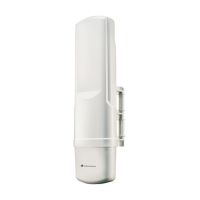AP_CMM2 User Manual Pa
e 3 of 49
Product Details for Products Tested for Compliance with Relevant EC Directives
(At this time, only the 5.7 GHz product has been tested for compliance with relevant EC directives.)
Operating
Frequency Range
Maximum
Transmitter
Power
Effective
Isotropic
Radiated
Power (EIRP)
Modulation
Type
Channel
Spacing
Access Point 5.725 to 5.825 GHz 200mW RMS 1 Watt EIRP High Index
BFSK
25 MHz
20 MHz
Subscriber
Module
5.725 to 5.825 GHz 200mW RMS 1 Watt EIRP High Index
BFSK
25 MHz
20 MHz
Subscriber
Module with
Reflector
5.725 to 5.825 GHz 200mW RMS 63 Watts EIRP High Index
BFSK
25 MHz
20 MHz
Backhaul 5.725 to 5.825 GHz 200mW RMS 1 Watt EIRP High Index
BFSK
25 Mhz
20 MHz
Backhaul
with Reflector
5.725 to 5.825 GHz 200mW RMS 63 Watts EIRP High Index
BFSK
25 MHz
20 MHz
Exposure Note
The Canopy Subscriber Module (SM) must be installed to provide a separation distance of at least
20 cm (7.9 in) from all persons, when adding the Canopy reflector dish (in the 5.7 GHz band), the
reflector dish must be installed to provide a separation distance of at least 1.5m (59.1 in) from all
persons and does not emit a RF field in excess of Health Canada limits for the general population;
consult Safety Code 6, obtainable from Health Canada’s website http://www.hc-sc.gc.ca/rpb.
In both configurations the maximum RMS power does not exceed 200mW.
The applicable power density exposure limit is 10 Watt/m
2
, according to the FCC OET Bulletin 65,
the ICNIRP guidelines, and the Health Canada Safety Code 6. The corresponding compliance
distances referenced above have been determined by assuming worst-case scenarios. The peak
power density (
S
) in the far-field of a radio-frequency source with rms transmit power
P
and
antenna gain
G
at a distance
d
is
2
4 d
GP
S
π
⋅
=
In the case of the Canopy SM
without
reflector, the gain is 8 dBi (a factor of 6.3), so the peak
power density equals the exposure limit at a distance of 10 cm. A four-fold additional compliance
margin is artificially introduced by doubling the distance to 20 cm.
In the case of the Canopy SM
with
reflector, the gain is 26 dBi (a factor of 400), so the peak power
density equals the exposure limit at a distance of about 80 cm. An almost four-fold additional
compliance margin is artificially introduced by defining the compliance distance of 1.5 m. The
compliance distance is greatly overestimated in this case because the far-field equation neglects
the physical dimension of the antenna, which is modeled as a point-source.
Software License Terms and Conditions
ONLY OPEN THE PACKAGE, OR USE THE SOFTWARE AND RELATED PRODUCT IF YOU
ACCEPT THE TERMS OF THIS LICENSE. BY BREAKING THE SEAL ON THIS DISK KIT /

